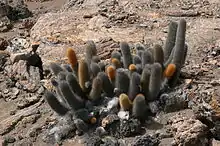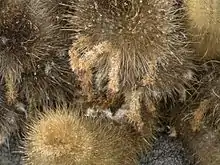Lava cactus
The lava cactus is a species of cactus, Brachycereus nesioticus, the sole species of the genus Brachycereus. The plant is a colonizer of lava fields – hence its common name – where it forms spiny clumps up to 60 cm (24 in) tall. Its solitary white or yellowish white flowers open in the daytime. It is endemic to the Galápagos Islands.
| Lava cactus | |
|---|---|
 | |
| Scientific classification | |
| Kingdom: | Plantae |
| Clade: | Tracheophytes |
| Clade: | Angiosperms |
| Clade: | Eudicots |
| Order: | Caryophyllales |
| Family: | Cactaceae |
| Subfamily: | Cactoideae |
| Genus: | Brachycereus Britton & Rose |
| Species: | B. nesioticus |
| Binomial name | |
| Brachycereus nesioticus | |
| Synonyms | |
|
Cereus nesioticus K.Schum. | |
Description
The lava cactus is a leafless clump-forming species, with cylindrical stems typically up to 50–60 cm (20–24 in) tall in formations that can be as much as 2 m (6 ft 7 in) across. The stems have 16–22 ribs and are yellow, with green or brown tones. Each areole has up to 40 spines, up to 5 cm (2 in) long, initially yellowish, but becoming darker with age. The flowers are borne singly, and are narrowly funnel-shaped, up to 11 cm (4 3⁄8 in) long and 5.5 cm (2 1⁄8 in) across, with many spines on the lower part of the flower. They open in the daytime and are white to yellowish white inside. The remains of the flower stay attached to the fruit, which is a berry, red to brown in colour, covered with yellow spines and filled with many black seeds.[2][3]

Taxonomy
The species was first described in 1902 as Cereus nesioticus by Karl Moritz Schumann in an account of the flora of Galápagos authored by Benjamin Lincoln Robinson.[4] In 1920, Nathaniel Lord Britton and Joseph Nelson Rose erected the genus Brachycereus, synonymizing Cereus nesioticus and another cactus from the Galápagos, Cereus thouarsii, under the name Brachycereus thouarsii.[5][6] In 1935, Curt Backeberg realized that only Cereus nesioticus belonged in Brachycereus (later placing Cereus thouarsii in Jasminocereus.)[5]
Brachycereus means "short cereus";[3] nesioticus is derived from the Ancient Greek νησιωτικός, meaning "of the islands".[7]
Phylogeny and classification
Molecular studies show that the two endemic Galápagos genera, Brachycereus and Jasminocereus, are sisters, with their closest relative being the South American mainland species Armatocereus:[8]
| |||||||||||||
In one widely used classification of cacti, Brachycereus is placed in the tribe Trichocereeae of the subfamily Cactoideae, while Armatocereus and Jasminocereus are placed in the tribe Browningieae,[9] which is inconsistent with the cladogram above. A classification produced in 2010 by Nyffeler and Eggli puts all three genera in a much larger tribe Phyllocacteae.[10]
Distribution and habitat
.JPG.webp)
The lava cactus is endemic to the Galápagos, where is found on Fernandina, Genovesa, Isabela, Pinta, Santa Cruz, and Santiago,[11] as well as some smaller islands,[2] including Bartolomé.[1] It grows on barren lava flows, both pāhoehoe and ʻaʻā.[2] It is one of the first species to grow on new lava flows.[1]
Conservation
Brachycereus nesioticus was rated as "vulnerable" in the IUCN Red List of 2000, but this was downgraded to "least concern" in 2013. As with all plants and animals of the Galápagos, collecting or disturbing the lava cactus is strictly controlled by the Ecuadorian government; the complete range of the species lies within the Galápagos National Park and Natural World Heritage Site. Trade in the species is controlled under CITES Appendix II.[1]
References
- Kling, M. & Tye, A. (2013), "Brachycereus nesioticus", IUCN Red List of Threatened Species, Version 2013.1, retrieved 2017-03-23
- McMullen, Conley K. (1999), Flowering Plants of the Galápagos, Ithaca, New York: Cornell University Press, ISBN 978-0-8014-8621-0, p. 321–322
- Anderson (2001), pp. 130–131
- "Cereus, Mill." in Robinson, B.L. (1902), "Flora of the Galapagos Islands", Proceedings of the American Academy of Arts and Sciences, 38 (4): 77–269, doi:10.2307/20021744, JSTOR 20021744
- Anderson, Edward F. (2001), The Cactus Family, Pentland, Oregon: Timber Press, ISBN 978-0-88192-498-5, p. 383
- Britton, N.L. & Rose, J.N. (1920), The Cactaceae : descriptions and illustrations of plants of the cactus family, Vol. 2, Washington: Carnegie Institution, pp. 120–121
- Liddell, Henry George & Scott, Robert (1940), "νησιωτικός", A Greek-English Lexicon (online version), Trustees of Tufts University, Oxford, retrieved 2017-03-24
- Gosline, Terrence M. (2009), "Galápagos Islands, Biology", in Gillespie, Rosemary G. & Clague, David A. (eds.), Encyclopedia of Islands, Berkeley: University of California Press, pp. 357–367, ISBN 978-0-520-25649-1
- Anderson (2001), pp. 102–103
- Nyffeler, R. & Eggli, U. (2010), "A farewell to dated ideas and concepts: molecular phylogenetics and a revised suprageneric classification of the family Cactaceae", Schumannia, 6: 109–149, doi:10.5167/uzh-43285
- "Brachycereus nesioticus", Galapagos Species Checklist, Charles Darwin Foundation, retrieved 2017-03-23
